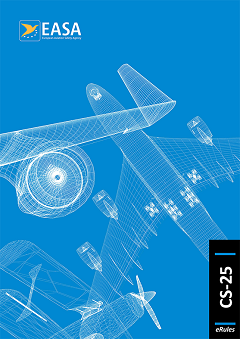CS 25.581 Lightning protection
ED Decision 2016/010/R
(See AMC 25.581)
(a)The aeroplane must be protected against catastrophic effects from lightning. (See CS 25.899 and AMC 25.581.)
(b) For metallic components, compliance with sub-paragraph (a) of this paragraph may be shown by –
(1) Bonding the components properly to the airframe; or
(2) Designing the components so that a strike will not endanger the aeroplane.
(c) For non-metallic components, compliance with sub-paragraph (a) of this paragraph may be shown by –
(1) Designing the components to minimise the effect of a strike; or
(2) Incorporating acceptable means of diverting the resulting electrical current so as not to endanger the aeroplane.
[Amdt 25/18]
AMC 25.581 Lightning protection
ED Decision 2020/024/R
1 INDUSTRY STANDARDS
The following documents may be used when showing compliance with CS 25.581:
— EUROCAE document ED-84A dated July 2013 (Aircraft Lightning Environment and Related Test Waveforms) or the equivalent SAE ARP5412B.
— EUROCAE document ED-91A (Aircraft Lightning Zoning) or the equivalent SAE ARP5414B.
— EUROCAE document ED-105A (Aircraft Lightning Test Methods) or the equivalent SAE ARP 5416A.
— EUROCAE document ED-113 (Aircraft Lightning Direct Effects Certification) or the equivalent SAE ARP 5577.
2 EXTERNAL METAL PARTS
2.1 External metal parts should either be –
a. Electrically bonded to the main earth system by primary bonding paths, or
b. So designed and/or protected that a lightning discharge to the part (e.g. a radio aerial) will cause only local damage which will not endanger the aeroplane or its occupants.
2.2 In addition, where internal linkages are connected to external parts (e.g. control surfaces), the linkages should be bonded to main earth or airframe by primary bonding paths as close to the external part as possible.
2.3 Where a primary conductor provides or supplements the primary bonding path across an operating jack (e.g. on control surfaces or nose droop) it should be of such an impedance and so designed as to limit to a safe value the passage of current through the jack.
2.4 In considering external metal parts, consideration should be given to all flight configurations (e.g. lowering of landing gear and wing-flaps) and also the possibility of damage to the aeroplane electrical system due to surges caused by strikes to protuberances (such as pitot heads) which have connections into the electrical system.
3 EXTERNAL NON-METALLIC PARTS
3.1 External non-metallic parts should be so designed and installed that –
a. They are provided with effective lightning diverters which will safely carry the lightning discharges described in EUROCAE document ED-84A dated July 2013 titled: Aircraft Lightning Environment and Related Test Waveforms, or the equivalent SAE ARP5412B document.
b. Damage to them by lightning discharges will not endanger the aeroplane or its occupants, or
c. A lightning strike on the insulated portion is improbable because of the shielding afforded by other portions of the aeroplane.
Where lightning diverters are used the surge carrying capacity and mechanical robustness of associated conductors should be at least equal to that required for primary conductors.
3.2 Where unprotected non-metallic parts are fitted externally to the aeroplane in situations where they may be exposed to lightning discharges (e.g. radomes) the risks include the following:
a. The disruption of the materials because of rapid expansion of gases within them (e.g. water vapour),
b. The rapid build-up of pressure in the enclosures provided by the parts, resulting in mechanical disruption of the parts themselves or of the structure enclosed by them,
c. Fire caused by the ignition of the materials themselves or of the materials contained within the enclosures, and
d. Holes in the non-metallic part which may present a hazard at high speeds.
3.3 The materials used should not absorb water and should be of high dielectric strength in order to encourage surface flash-over rather than puncture. Laminates made entirely from solid material are preferable to those incorporating laminations of cellular material.
3.4 Those external non-metallic part which is not classified as primary structure should be protected by primary conductors.
3.5 Where damage to an external non-metallic part which is not classified as primary structure may endanger the aeroplane, the part should be protected by adequate lightning diverters.
3.6 Confirmatory tests may be required to check the adequacy of the lightning protection provided (e.g. to confirm the adequacy of the location and size of bonding strips on a large radome.)
